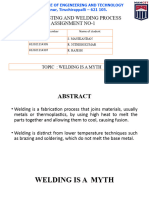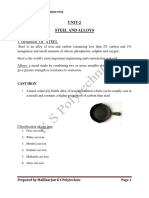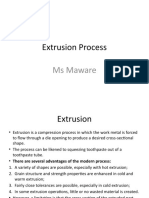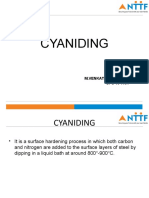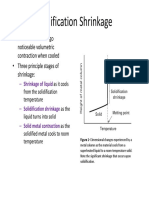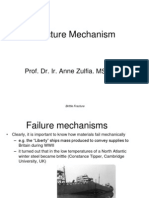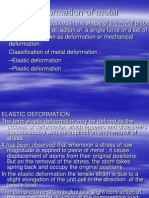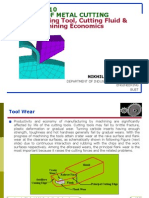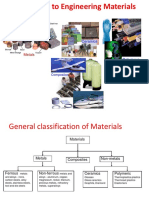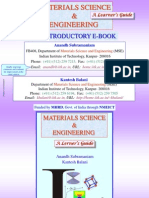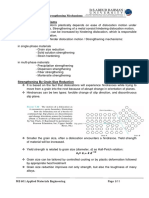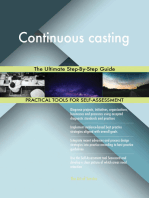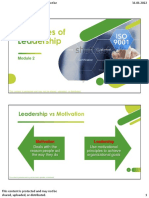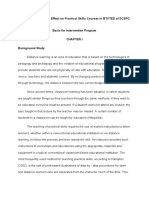0 ratings0% found this document useful (0 votes)
60 viewsMP Lecture Unit 3 Forming
This document provides an overview of forming and shaping processes in manufacturing. It discusses forming, which changes the shape of a solid body using processes like rolling and forging, and shaping, which involves molding and casting to produce a part near its final shape. Key terms like ingot, billet, slab, plate, sheet, and strip are defined. Plastic deformation processes are used to convert cast structures into wrought structures with improved properties. Forming can be done through both hot and cold working, with various advantages and disadvantages discussed for each.
Uploaded by
aakash sharmaCopyright
© © All Rights Reserved
Available Formats
Download as PPTX, PDF, TXT or read online on Scribd
0 ratings0% found this document useful (0 votes)
60 viewsMP Lecture Unit 3 Forming
This document provides an overview of forming and shaping processes in manufacturing. It discusses forming, which changes the shape of a solid body using processes like rolling and forging, and shaping, which involves molding and casting to produce a part near its final shape. Key terms like ingot, billet, slab, plate, sheet, and strip are defined. Plastic deformation processes are used to convert cast structures into wrought structures with improved properties. Forming can be done through both hot and cold working, with various advantages and disadvantages discussed for each.
Uploaded by
aakash sharmaCopyright
© © All Rights Reserved
Available Formats
Download as PPTX, PDF, TXT or read online on Scribd
You are on page 1/ 21
Course: Manufacturing Processes
Course Code: ES119
Unit III: FORMING
By: Dr. Sumit Joshi
Assistant Professor (ME/MAE deptt)
MAIT, New Delhi
Forming and Shaping
• Forming: generally indicates changing the shape of an
existing solid body. Starting material (usually called the
workpiece, stock, or blank) may be in the shape of a
plate, sheet, bar, rod, wire, or tubing.
• Shaping: processes typically involve molding and casting,
producing a part that generally is at or near the final
desired shape.
• The initial raw material used in forming and shaping
metals is usually molten metal, which is cast into
individual ingots or continuously cast into slabs, rods, or
pipes. Cast structures are converted to wrought
structures by plastic-deformation processes.
Terminologies
Semi‐finished product
• Ingot: is the first solid form of
steel.
• Bloom: is the product of first
breakdown of ingot has
square cross section 6 x 6 in.
or larger
• Billet: is hot rolled from a
bloom and is square, 1.5 in.
on a side or larger.
• Slab: is the hot rolled ingot or
bloom rectangular cross
section 10 in. or more wide
and 1.5 in. or more thick.
Terminologies
Mill product
• Plate is the product with thickness > 5 mm
• Sheet is the product with thickness < 5 mm and width >
600 mm
• Strip is the product with a thickness < 5 mm and width <
600 mm
Metal working or Metal Forming
• Metal working processes are used to achieve optimum
mechanical properties in the metal.
• Metal working reduces any internal voids or cavities
present, and thus make the metal dense. The impurities
present in the metal also get elongated with the grains
and in the process they get broken and dispersed
throughout the metal. This decreases the harmful effects
of the impurities and improves the mechanical strength.
• Cast structures are converted to wrought structures by
plastic-deformation processes.
Plastic Deformation
• Deformation which is permanent and beyond the elastic
range of the material.
• The necessary deformation in a metal can be achieved by
application of large amount of mechanical force only, or
by heating the metal and then applying a small force.
• The deformation of metals is achieved by one or both of
the microscopic deformation processes called slip and
twinning.
• On the macroscopic scale, when plastic deformation
occurs, the metal appears to flow in the solid state along
specific directions.
Metal working characteristics
• The crystals or grains of the metal are
elongated in the direction of metal flow. These
visible lines are called ‘fibre flow lines’.
• Mechanically worked metals called wrought
products achieve better mechanical strength
in specific orientation, that of the flow
direction. Since it is possible to control these
flow lines in any specific direction by careful
manipulation of the applied forces, it is
possible to achieve optimum mechanical
properties.
• The wastage of material in metal-working
processes is either negligible or very small,
and the production rate is in general very high.
These two factors give rise to the economy in
production.
Bulk deformation processes
• These processes involve large amount of plastic
deformation.
• The cross‐section of workpiece changes without
volume change.
• For most operations, hot or warm working
conditions are preferred although some
operations are carried out at room temperature.
Sheet forming processes
• In sheet metal working operations, the cross‐
section of workpiece does not change—the
material is only subjected to shape changes.
• Sheet metal working metal working operations
are performed on thin (less than 5 mm) sheets,
strips or coils of metal by means of a set of tools
call de punch and die on machine tools called
stamping presses.
• They are always performed as cold working
operations
Hot working & Cold working
• The metal-working processes are traditionally divided into
hot working and cold-working processes.
• The division is on the basis of the amount of heating
applied to the metal before applying the mechanical force.
• Those processes, working above the Recrystallization
temperature, are termed as hot-working processes.
• Those processes, working below the Recrystallization
temperature, are termed as cold-working processes.
Recrystallization
• Under the action of heat and the force, when the atoms
reach a certain higher energy level, the new crystals start
forming which is termed as Recrystallization.
• Recrystallization destroys the old grain structure deformed
by the mechanical working, and entirely new strain free
crystals are formed.
• The minimum temperature at which the completed
recrystallization of a cold worked metal occurs within a
specified period of approximately one hour is called
Recrystallization (Rx) Temperature.
• Rx temp. depends on the amount of cold work a material
has already received. The higher the cold work, the lower
would be the Rx temp.
Recrystallization contd……
• Rx temp. varies between 1/3 to ½ melting point.
• For Pure metal Rx temp. = 0.3 x Melting temp. (Kelvin).
• For Alloy Rx temp. = 0.5 x Melting temp. (Kelvin)
• Rx temp. of lead and Tin is below room temp
• Rx temp. of Cadmium and Zinc is room temp.
• Rx temp. of Iron is 450oC and for steels around 1000°C.
• Finer is the initial grain size; lower will be the Rx temp
Advantages of Cold working
• Better accuracy, closer
tolerances.
• Better surface finish.
• Strain hardening increases
strength and hardness.
• Grain flow during
deformation can cause
desirable directional
properties in product
• No heating of work
required (less total energy)
Strain hardening
• When metal is formed in cold state, there is no
Recrystallization of grains and thus recovery from grain
distortion or fragmentation does not take place.
• As grain deformation proceeds, greater resistance to this
action results in increased hardness and strength i.e. strain
hardening.
Disadvantages of Cold working
• Equipment of higher forces and power required.
• Surfaces of starting work piece must be free of scale and
dirt.
• Ductility and strain hardening limit the amount of
forming that can be done.
• In some operations, metal must be annealed to allow
further deformation.
• Some metals are simply not ductile enough to be cold
worked
Annealing
• Annealing relieves the stresses from cold working –
three stages: recovery recrystallization and grain
growth.
• During recovery, physical properties of the cold‐worked
material are restored without any observable change in
microstructure.
Advantages of hot working
• The porosity of the metal is largely eliminated.
• The grain structure of the metal is refined.
• The impurities like slag are squeezed into fibers and distributed
throughout the metal.
• Mechanical properties such as toughness, ductility and resistance
to shock and vibration are improved due to the refinement of
grains.
Disadvantages of hot working
• It requires expensive tools.
• It produces poor surface finish, due to the rapid
oxidation and scale formation on the metal
surface.
• Due to the poor surface finish, close tolerance
cannot be maintained.
Forming Techniques
• Rolling: The process of plastically deforming
metal by passing it between rolls.
• Forging: is a metal working process by which
metals or alloys are plastically deformed to the
desired shapes by a compressive force applied
with the help of a pair of dies.
• Extrusion: The work material is forced to flow
through a die opening taking its shape
• Drawing: The diameter of a wire or bar is reduced
by pulling it through a die opening (bar drawing)
or a series of die openings (wire drawing)
Rolling
• The process of plastically
deforming metal by passing it
between rolls.
• Most widely used, high
production and close
tolerance.
• Friction between the rolls and
the metal surface produces
high compressive stress.
• Metal will undergo bi‐axial
compression.
• E.g. Rail, channel, angle
You might also like
- Analysing Political Speeches Rhetoric, Discourse and Metaphor (Jonathan Charteris-Black) (Z-Library)No ratings yetAnalysing Political Speeches Rhetoric, Discourse and Metaphor (Jonathan Charteris-Black) (Z-Library)314 pages
- 20ME403 Engineering Materials and Metallurgy Unit - IV Digital MaterialNo ratings yet20ME403 Engineering Materials and Metallurgy Unit - IV Digital Material55 pages
- Lecture 7-8 PPT Slides - Materials StrengtheningNo ratings yetLecture 7-8 PPT Slides - Materials Strengthening47 pages
- Cyaniding: M.Venkatesh Prabhu SPG 16 1431No ratings yetCyaniding: M.Venkatesh Prabhu SPG 16 143111 pages
- Engineering Materials & Metallurgy Question Bank67% (3)Engineering Materials & Metallurgy Question Bank7 pages
- Me6302 - Manufacturing Technology - I: Iii Semester Mechanical EngineeringNo ratings yetMe6302 - Manufacturing Technology - I: Iii Semester Mechanical Engineering69 pages
- A Seminar Presentation On: "Ultrasonic Welding"100% (1)A Seminar Presentation On: "Ultrasonic Welding"14 pages
- 2.1 Solidification, Imperfection (Defect) in Solids, and DiffusionNo ratings yet2.1 Solidification, Imperfection (Defect) in Solids, and Diffusion54 pages
- Spacetec Certification Readiness Course: Materials and Processes I & IiNo ratings yetSpacetec Certification Readiness Course: Materials and Processes I & Ii68 pages
- Strengthening Mechanisms For Metals and AlloysNo ratings yetStrengthening Mechanisms For Metals and Alloys15 pages
- Metal Casting Design: Mold and Gating System Design, Directional Solidification, and TroubleshootingNo ratings yetMetal Casting Design: Mold and Gating System Design, Directional Solidification, and Troubleshooting7 pages
- THEORY of METAL CUTTING-Cutting Tool, Cutting Fluid & Machining Economics75% (4)THEORY of METAL CUTTING-Cutting Tool, Cutting Fluid & Machining Economics17 pages
- The Effect of Current On SMAW Welding To Tensile Strength and Micro Structure of Low Carbon SteelNo ratings yetThe Effect of Current On SMAW Welding To Tensile Strength and Micro Structure of Low Carbon Steel5 pages
- MCL-135-Welding and Allied Processes - Class 11-15No ratings yetMCL-135-Welding and Allied Processes - Class 11-1558 pages
- Year: Iv - I Mech: Unconventional Machining ProcessesNo ratings yetYear: Iv - I Mech: Unconventional Machining Processes26 pages
- 11 Introduction To Engineering MaterialsNo ratings yet11 Introduction To Engineering Materials20 pages
- Materials Science & Engineering Introductory E-BookNo ratings yetMaterials Science & Engineering Introductory E-Book13 pages
- Industrial Profile: Hutti Gold Mines Company LimitedNo ratings yetIndustrial Profile: Hutti Gold Mines Company Limited78 pages
- CV For Road Safety Specialist - PDF - CompressedNo ratings yetCV For Road Safety Specialist - PDF - Compressed8 pages
- Chapter Three Chapter Three The Multiple Linear Regression (MLR)No ratings yetChapter Three Chapter Three The Multiple Linear Regression (MLR)50 pages
- A Novel Oil-Immersed Medium Frequency Transformer For Offshore HVDC Wind FarmsNo ratings yetA Novel Oil-Immersed Medium Frequency Transformer For Offshore HVDC Wind Farms11 pages
- MineScape 5.7 Hotfix 1 Release Notes and Installation Guide - EN PDF67% (3)MineScape 5.7 Hotfix 1 Release Notes and Installation Guide - EN PDF19 pages
- Module-2 Notes Biology For Engineers....No ratings yetModule-2 Notes Biology For Engineers....14 pages
- Performance Assessment and Review Admin and Accounts ManagersNo ratings yetPerformance Assessment and Review Admin and Accounts Managers3 pages
- Distance Learning and Effect On Practical Skills Courses in BTVTED of ZCSPCNo ratings yetDistance Learning and Effect On Practical Skills Courses in BTVTED of ZCSPC12 pages
- Multicast Part of The CCIE EI Workbook Orhan ErgunNo ratings yetMulticast Part of The CCIE EI Workbook Orhan Ergun32 pages
- Analysing Political Speeches Rhetoric, Discourse and Metaphor (Jonathan Charteris-Black) (Z-Library)Analysing Political Speeches Rhetoric, Discourse and Metaphor (Jonathan Charteris-Black) (Z-Library)
- 20ME403 Engineering Materials and Metallurgy Unit - IV Digital Material20ME403 Engineering Materials and Metallurgy Unit - IV Digital Material
- Me6302 - Manufacturing Technology - I: Iii Semester Mechanical EngineeringMe6302 - Manufacturing Technology - I: Iii Semester Mechanical Engineering
- 2.1 Solidification, Imperfection (Defect) in Solids, and Diffusion2.1 Solidification, Imperfection (Defect) in Solids, and Diffusion
- Spacetec Certification Readiness Course: Materials and Processes I & IiSpacetec Certification Readiness Course: Materials and Processes I & Ii
- Metal Casting Design: Mold and Gating System Design, Directional Solidification, and TroubleshootingMetal Casting Design: Mold and Gating System Design, Directional Solidification, and Troubleshooting
- THEORY of METAL CUTTING-Cutting Tool, Cutting Fluid & Machining EconomicsTHEORY of METAL CUTTING-Cutting Tool, Cutting Fluid & Machining Economics
- The Effect of Current On SMAW Welding To Tensile Strength and Micro Structure of Low Carbon SteelThe Effect of Current On SMAW Welding To Tensile Strength and Micro Structure of Low Carbon Steel
- MCL-135-Welding and Allied Processes - Class 11-15MCL-135-Welding and Allied Processes - Class 11-15
- Year: Iv - I Mech: Unconventional Machining ProcessesYear: Iv - I Mech: Unconventional Machining Processes
- Materials Science & Engineering Introductory E-BookMaterials Science & Engineering Introductory E-Book
- Continuous casting The Ultimate Step-By-Step GuideFrom EverandContinuous casting The Ultimate Step-By-Step Guide
- Industrial Profile: Hutti Gold Mines Company LimitedIndustrial Profile: Hutti Gold Mines Company Limited
- Chapter Three Chapter Three The Multiple Linear Regression (MLR)Chapter Three Chapter Three The Multiple Linear Regression (MLR)
- A Novel Oil-Immersed Medium Frequency Transformer For Offshore HVDC Wind FarmsA Novel Oil-Immersed Medium Frequency Transformer For Offshore HVDC Wind Farms
- MineScape 5.7 Hotfix 1 Release Notes and Installation Guide - EN PDFMineScape 5.7 Hotfix 1 Release Notes and Installation Guide - EN PDF
- Performance Assessment and Review Admin and Accounts ManagersPerformance Assessment and Review Admin and Accounts Managers
- Distance Learning and Effect On Practical Skills Courses in BTVTED of ZCSPCDistance Learning and Effect On Practical Skills Courses in BTVTED of ZCSPC
- Multicast Part of The CCIE EI Workbook Orhan ErgunMulticast Part of The CCIE EI Workbook Orhan Ergun

